ВУЗ: Не указан
Категория: Не указан
Дисциплина: Не указана
Добавлен: 19.03.2024
Просмотров: 53
Скачиваний: 0



Підставимо рівняння (1.7) до рівняння (1.2):






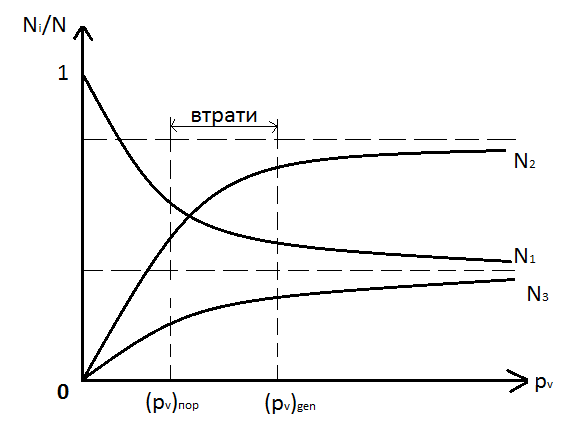
Рисунок 2. Залежності вiдносної заселеностi рiвнiв вiд спектральної густини енергії накачування.
Розділ 2. Теоретичні відомості про лазери Завдання 2
How gas-ion lasers work
Ion lasers produce a large number of high-power lasing wavelengths ranging from the ultraviolet, through the visible, into the near infrared portion of the spectrum. Ion lasers are compact for the amount of laser power they generate relative to other types of visible lasers.
Almost all commercial ion lasers manufactured today are CW argon or krypton lasers. We specialize in refining these types to yield extremely reliable long-life ion lasers with the best optical stability, the lowest optical noise and the maximum wavelength range, power and beam versatility obtainable.
Argon laser characteristics
Argon-ion lasers produce the highest visible power levels and have up to ten lasing wavelengths in the blue and green portion of the spectrum. The chart below shows the typical lasing wavelengths and relative power levels obtainable from a 4-watt size argon laser.
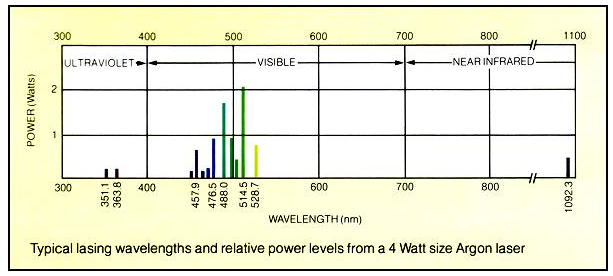
Argon lasers are normally rated by the power level produced by the six simultaneously lasing wavelengths from 514.5 nm to 457.9 nm. The most prominent and most used wavelengths in the argon laser are the 514.5 nm green line and the 488.0 nm blue line. The wavelengths outside of the standard visible range, including a highly stable infrared line at 1090 nm, are available simply by changing mirrors. The UV wavelengths are produced from double-ionized transitions which require higher than normal laser current levels, and are therefore available only from the highest power models.
Krypton laser characteristics
Krypton-ion lasers are almost identical in construction, reliability and operating life to argon lasers. Under some conditions krypton lasers can produce wavelengths over the full visible spectrum with lines in the red, yellow, green and blue. The 647.1 nm and 676.4 nm red lines are the strongest and result in the best performance.
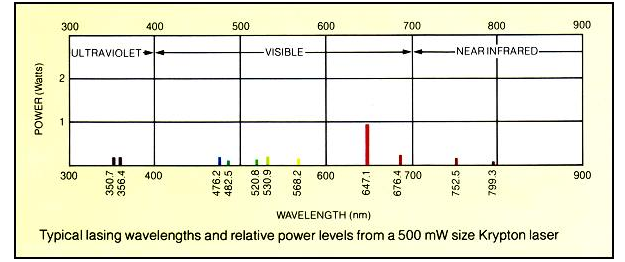
Krypton lasers are normally rated by the power level produced at 647.1 nm. This wavelength is the most frequently used because it can produce more red laser light than can be obtained from other types of lasers.
The basic multiline laser
In its simplest configuration an ion laser is a multiline laser producing a number of simultaneously lasing wavelengths. The figure to the right shows the optical configuration of a basic multiline argon laser. The mirror arrangement consists of a rear High Reflector and an output Transmitter aligned with the plasma tube to produce lasing.
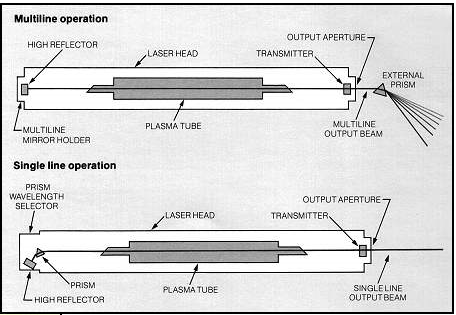
With standard mirror coatings the output beam of an argon laser consists of six discrete wavelengths emitted together. They can be separated into their individual lines by using an external prism or other dispersive elements as illustrated. The approximate distribution of the output power among the six wavelengths of a multiline argon laser operating at full rated power is given in this chart:

Single line laser output
Most laser applications require that only one laser wavelength be produced at a time. Single line operation is achieved by replacing the multiline rear mirror with a Prism Wavelength Selector, as shown in the lower part of the diagram above. This assembly consists of an internal prism aligned to properly deflect the intracavity optical path to the High Reflector.
Because of the dispersive properties of the prism, only one wavelength at a time will be properly aligned and produce lasing. The wavelength selector thus allows easy tunability and selection of any of the individual lasing wavelengths. The power available from a single line using a prism wavelength selector is usually greater than the power that can be obtained from the same wavelength by splitting a multiline beam with an external prism. See the detailed wavelength and power table, to find the single line power available from a Lexel laser.
Transverse modes
The transverse electromagnetic mode (TEM) structure of a laser beam describes the power distribution across the beam. Most laser applications require a fundamental mode beam (TEM00) with a Gaussian power distribution across the beam as shown to the right. This fundamental mode results in the smallest beam diameter and beam divergence and is capable of being focused to the smallest possible spot size.
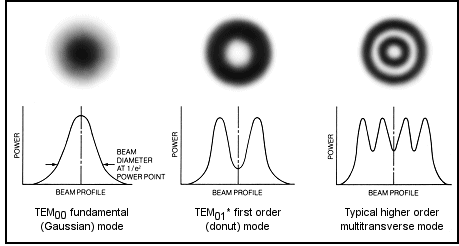
Other applications profit from the increased power available in the first order mode (TEM01*) or even higher order modes. Laser output having a mode structure above the fundamental is commonly referred to as multitransverse mode (MTM). The mode structure produced by the laser can be changed simply by changing mirrors. We provides the proper mirrors for either fundamental or multimode operation.
Beam diameter and divergence
The diameter of a Gaussian laser beam is conventionally measured at the 1 /e2 power point, i.e., it is the diameter of an aperture stop that will pass 86.5% of the total laser power at the plane of the output mirror. The beam divergence is usually given as the full angle divergence measured in the far field. Both parameters are directly related to the laser wavelength, mirror spacing and curvature of the mirrors.
Diameter and divergence values for selected ion laser wavelengths are available for the Lexel 85/95 series, the Lexel 85-SHG and for the Lexel 95-SHG. A full discussion of laser beam parameters is given by Kogelnik and Li, "Laser Beams and Resonators", Applied Optics, Vol. 5, page 1550, Oct. 1966.
Single frequency operation
The output of a laser operating on a single wavelength has a very narrow linewidth and extremely good coherence compared to any other type of light. However, the laser line is actually made up of a large number of longitudinal modes spaced over a frequency bandwidth of approximately 5 GHz. These modes are related to the distance between the two mirrors making up the optical cavity. The frequency spacing between these longitudinal modes is c/2L, where c is the velocity of light and L is the mirror spacing. Thus a 1 meter cavity length has a 150 MHz longitudinal mode spacing.
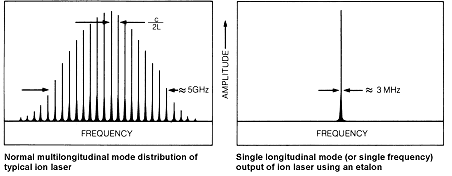
The "coherence length", i.e., the path distance over which the laser wavefront remains in phase and usable for interferometric effects, is approximately given by c/Δv, whereΔv is the frequency bandwidth of the laser line. The normal multilongitudinal mode (MLM) output of an ion laser, therefore, has a coherence length of about 60 mm.
Many applications such as holography and long-path interferometry or Brillouin scattering require a much longer coherence length and a very narrow linewidth. This is accomplished in an ion laser by installing an etalon, such as the Lexel Model 503 Etalon, in the laser cavity as shown in the figure above. A properly designed intracavity etalon will reject all of the longitudinal modes except one and cause laser power to be concentrated in this single mode. Since a single longitudinal mode has a width of less than 3 MHz the resulting coherence length can be more than 100 meters.
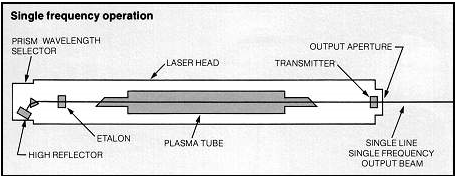
Laser output using an etalon is known as Single Longitudinal Mode (SLM) or Single Frequency Operation.
Beam-pointing stability
The ability of the laser to maintain a precise angular beam position is very important for most applications. This requires a very stable optical resonator such as Lexel's Solid Invar® Rod Resonator Structure.
The major additional factor affecting beam-pointing stability is the thermal change in the index of refraction of the quartz used in the prism wavelength selector. The properties of quartz are such that, if left uncorrected, it will detune the laser at a rate of 0.2 nm/ °C and cause an angular change in the beam-pointing of 11 arc sec/ °C. This is enough to completely detune the laser with as little as a 10°C change in ambient temperature.
A Temperature Compensated Prism Wavelength Selector is needed to eliminate thermal detuning and provide the best possible beam-pointing stability.
Beam polarization
The windows of the laser plasma tube through which the laser light must pass are aligned at Brewster's angle to eliminate the high reflective losses from the surfaces of the windows. This results in the additional benefit of the laser output beam being highly polarized in the vertical plane. If it is necessary to have polarization at any other direction, the laser head may be turned 90 degrees and operated on its side. Or a polarization rotator may be attached to the output aperture of the laser. This will allow the output beam polarization to be changed to any desired plane.
Laser power control and stabilization
Current Control The output power of an ion laser can easily be set at any level between full output and the threshold of lasing by adjusting the level of the power supply's laser current through the plasma tube. Current Control permits good power stabilization for many applications but it requires manual compensation for any optical variations that may cause slight changes in the laser power level.
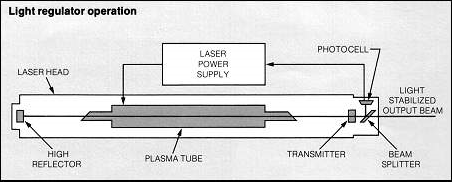
Light Control For the ultimate in laser power stabilization, a Light Regulator circuit is used. Under this type of light control a small portion of the output beam is split off and measured by a photocell. The output of the photocell is amplified and compared to a reference signal in a differential circuit that automatically readjusts the laser current level to maintain the desired laser power. The operator can easily set the laser power to any desired level and be assured that the Light Regulator will continue to maintain that level throughout extended operation.
Переклад
Як працюють газово-іонні лазери
Іонні лазери виробляють велику кількість потужних генераційних довжин хвиль в діапазоні від ультрафіолетової області спектра, через видимий, до ближньої інфрачервоної частини спектра. Іонні лазери компактні по відношенню до інших типів лазерів видимого діапазону.
Майже всі комерційні іонні лазери, вироблені сьогодні - це CW аргонові чи криптонові лазери. Ми спеціалізуємося на переробці цих типів, щоб отримати надзвичайно надійні довговічні іонні лазери з кращою оптичною стабільністю, найнижчим оптичним шумом і максимальним діапазоном довжин хвиль а також потужныстю для одержуваного універсального променя.
Характеристики аргонового лазера.
Аргон-іонні лазери виробляють найвищі видимі рівні потужності і мають до десяти довжин хвиль генерації в синій та зеленій частині спектра. У наведеній нижче таблиці показані типові довжин хвиль генерації і відносні рівні потужності, одержувані від аргонового лазера потужністю 4 Вт.
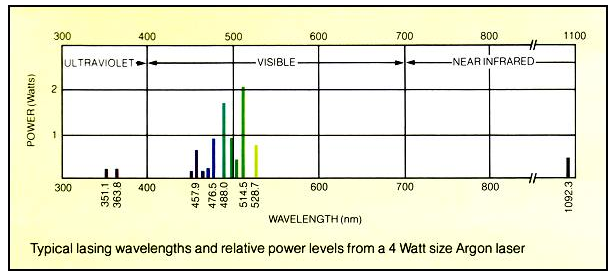
Аргонові лазери зазвичай оцінюють рівень потужності, створювану одночасно шістьма довжинами хвиль генерації від 514,5 нм до 457,9 нм. Найбільш відомими і найбільш часто використовуваними довжинами хвиль в аргоновому лазері є зелена лінія 514,5 нм і синя лінія 488,0 нм. Довжини хвиль за межами видимого стандартного діапазону, в тому числі високостабільної інфрачервоної лінії на 1090 нм, можна згенерувати шляхом зміни дзеркал. УФ-хвилі виробляються з подвійних іонізованих переходів, які вимагають більше, ніж звичайний струм лазерних рівнів, і тому доступні тільки для самих потужних моделей.
Характеристики криптонового лазера
Криптон-іонні лазери практично ідентичні по конструкції, надійності і терміну експлуатації від лазерів аргону. У деяких умовах криптонові лазери можуть виробляти довжини хвиль по всій видимій області спектра з лініями в червоний, жовтий, зелений і синій. На 647,1 нм і 676,4 нм червоні лінії є найсильнішими і призводять до кращої продуктивності.
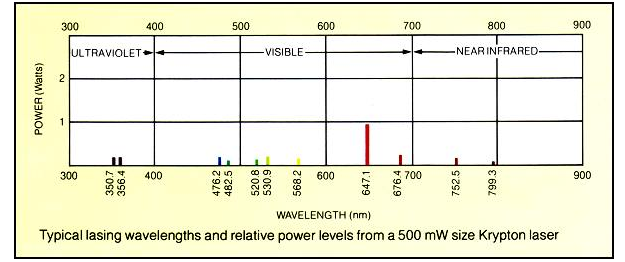
Криптонові лазери зазвичай мають рівень потужності, виробленої на 647,1 нм. Ця довжина хвилі є найбільш часто використовуваною, так як вона може виробляти більше червоне світло лазера, ніж інші типи лазерів.


